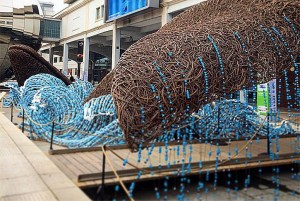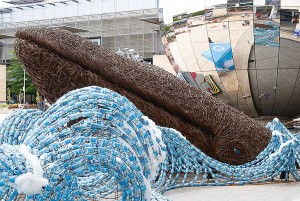Clearly, road races need to adopt green alternatives to using plastic bottles at races. Thankfully, more and more races have begun this process – adopting “green” initiatives – including, among other things, discontinuing the use of plastic bottles at races (see, e.g. River Valley Run) – but this is just a start to the solution.
A reader (Wendy) brought this article in Takepart, entitled See the Whales Swimming in an Ocean of 70,000 Plastic Water Bottles written by Liz Dwyer, to my attention.
The focus of the Takepart article is a public art installation project in Bristol, England, of a whale, woven from biodegradable willow and the waves under the whale, which are constructed from 70,000 plastic water bottles discarded by spectators and runners at two local road races. Obviously, the spotlight of the installation is to bring to light the problem of single-use containers.

photo:http://www.takepart.com/article/2015/08/30/see-whales-swimming-ocean-of-70000-plastic-water-bottles
Designed and built by Cod Steaks, initiated by Artists Project Earth and funded by Arts Council England, [the public art installation of] the Bristol Whales represents the beauty and fragility of our oceans and the increasing human threats that they face
(http://codsteaks.com/portfolio/public-art/the-bristol-whales)
The Takepart article states, in relevant part:
Running a road race—whether it’s a 5K, 10K, half marathon, or the grueling 26.2-mile distance of a full marathon—is certainly an accomplishment worth celebrating. But after the cheering crowds have dispersed and the athletes have gone home with their medals, there’s usually plenty of garbage left behind on the pavement, including tens of thousands of plastic water bottles.
Facing criticism that running events are an “environmental disaster,” races are increasingly touting their sustainability. But the folks at Cod Steaks, a Bristol, England–based design and model-making firm, decided to use the water bottles left behind after this year’s Bath Marathon and Bristol 10K to turn the spotlight on a broader issue: the amount of plastic marine life in the world’s oceans has to swim through.
With funding from Arts Council England and in collaboration with Artists Project Earth, Cod Steaks created “The Bristol Whales,” a life-size environmental art installation in Bristol’s city center. It depicts two of the massive mammals emerging out of an “ocean” of plastic.

photo:http://www.takepart.com/article/2015/08/30/see-whales-swimming-ocean-of-70000-plastic-water-bottles
The whale heads are nearly 30 feet long and weigh 2.5 tons each, while the tails are almost 50 feet long and weigh 3.5 tons each. They’re woven from biodegradable willow that grows in abundance in the area, But the waves of water are constructed from 70,000 plastic water bottles discarded by spectators and runners at the two road races. The bottles that make up the whale bodies were strung together on a steel frame, and the droplets of water are bottle caps. A bit of bubble wrap was added to the tops of the waves to resemble foam, and at night the installation is illuminated with LED lighting.
For further information, see: http://bristolwhales.tumblr.com/ and http://codsteaks.com/portfolio/public-art/the-bristol-whales
Stay tuned for a follow-up post this week containing suggestions on how both runners and travelers (or both if you are a runner who travels) can reduce plastic bottle usage and waste, and some suggestions on environmentally-responsible hydration products for purchase that will make your life easier!

 A New York frequent flyer who elegantly combines her passions for worldwide travel, running a gazillion marathons all over the globe and staying fit ... without sacrificing her fancy for good wine and food.
A New York frequent flyer who elegantly combines her passions for worldwide travel, running a gazillion marathons all over the globe and staying fit ... without sacrificing her fancy for good wine and food.
Leave a Reply